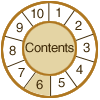

6D.
Technical Infrastructure:
DELIVERY
Key Concepts
introduction
networks
concerns
speed
trends
monitors
evaluation
image
quality
printers
technologies
evaluation
PRINTERS
As long as computers are bulky, display devices low resolution and hard
on the eyes, battery technology in its infancy, and the communications
infrastructure bound by cables, the desire to create printouts from digital
images will endure. However, the costs of actually making high-resolution
images available online, in formats that can be printed via a number of
platforms and a range of printers, should not be underestimated. Before
making promises to deliver print-quality images in a networked environment,
verify that the technical infrastructure is up to the task, and consider
the additional storage costs associated with online access.
PRINTER
TECHNOLOGIES
Today, black and white printing is dominated by two technologies: Inkjet
printers, which squirt liquid ink through tiny nozzles onto the paper,
and laser printers, which use a light source to create charges on a photoconductive
drum, allowing it to attract dry ink particles (toner) that fuse onto
paper. Inkjet printers have become quite inexpensive, but are slower than
lasers and generally not designed for high volume printing. High end production
laser printers can produce well over 100 pages per minute at 600 dpi.
Both technologies have been adopted for color. Color inkjet printers come in 3- and 4-color models. Color lasers are much more expensive, both for initial purchase and for the cost of consumables. Color inkjets and lasers are both substantially slower than their black and white counterparts, color inkjets average about 5 pages per minute for text and 1 page per minute for full page graphics. Color lasers are faster, averaging 12 pages per minute for text, and 2 pages per minute for full page graphics.
Several other technologies are available for color printing. These include dye sublimation, solid ink, and thermal wax. Dye sublimation is especially significant in that it can produce true continuous tone color printouts, though it is extremely slow and requires special coated paper.
For
larger scale color printing, Electronics for Imaging makes the Fiery line
of print servers, which enable digital color photocopiers and digital
presses to be networked to serve as high volume, high quality color printers.
The resulting combination is called a copier-printer. Resolution is generally
400 dpi maximum, but is supported for whatever paper sizes the copier
normally uses.
© 2000-2003 Cornell University Library/Research Department